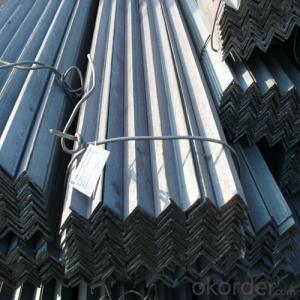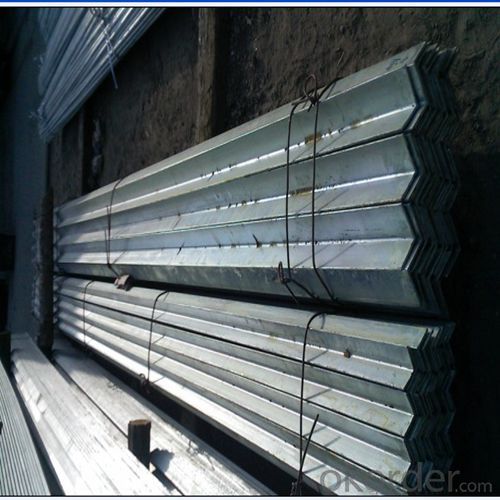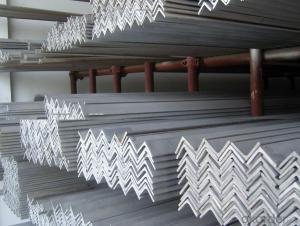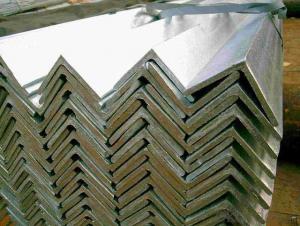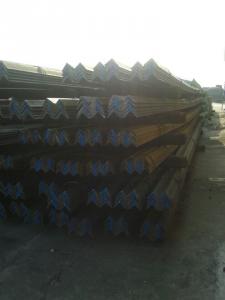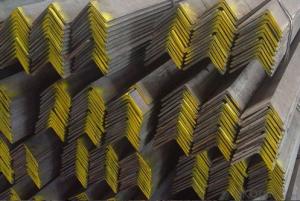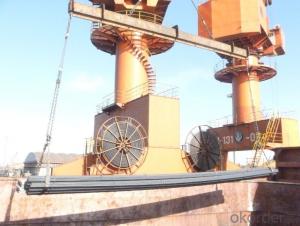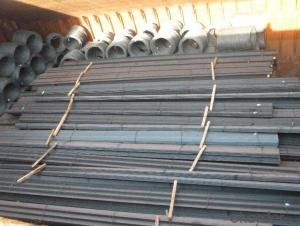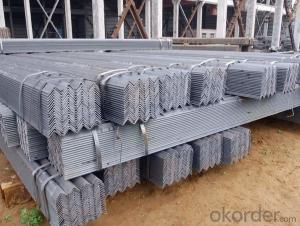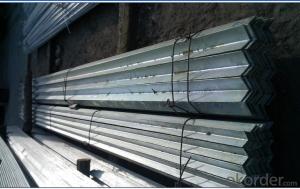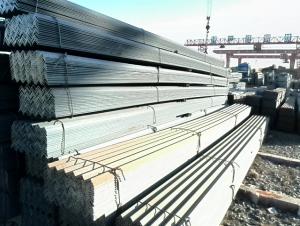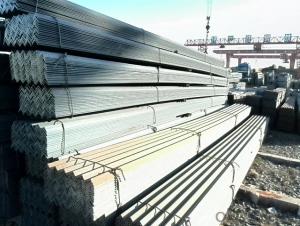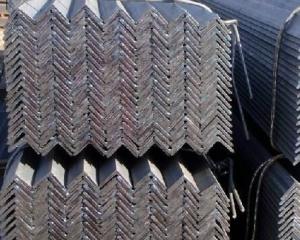Hot Rolled Steel Equal Angle Unequal Angle
- Loading Port:
- Tianjin
- Payment Terms:
- TT or LC
- Min Order Qty:
- 50 m.t.
- Supply Capability:
- 30000 m.t./month
OKorder Service Pledge
OKorder Financial Service
You Might Also Like
Product Description:
OKorder is offeringHot Rolled Steel Equal Angle Unequal Angle at great prices with worldwide shipping. Our supplier is a world-class manufacturer of steel, with our products utilized the world over. OKorder annually supplies products to European, North American and Asian markets. We provide quotations within 24 hours of receiving an inquiry and guarantee competitive prices.
Product Applications:
Hot Rolled Steel Equal Angle Unequal Angle are ideal for structural applications and are widely used in the construction of buildings and bridges, and the manufacturing, petrochemical, and transportation industries.
Product Advantages:
OKorder's Hot Rolled Steel Equal Angle Unequal Angle are durable, strong, and resist corrosion.
Main Product Features:
· Premium quality
· Prompt delivery & seaworthy packing (30 days after receiving deposit)
· Corrosion resistance
· Can be recycled and reused
· Mill test certification
· Professional Service
· Competitive pricing
Product Specifications:
Specifications of Angle Steel
1. Invoicing on theoretical weight or actual weight as customer request
2. Length: 6m, 9m, 12m as following table
3. Sizes
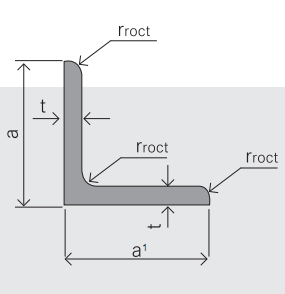
Sizes: 25mm-250mm | ||
a*t | ||
25*2.5-4.0 | 70*6.0-9.0 | 130*9.0-15 |
30*2.5-6.6 | 75*6.0-9.0 | 140*10-14 |
36*3.0-5.0 | 80*5.0-10 | 150*10-20 |
38*2.3-6.0 | 90*7.0-10 | 160*10-16 |
40*3.0-5.0 | 100*6.0-12 | 175*12-15 |
45*4.0-6.0 | 110*8.0-10 | 180*12-18 |
50*4.0-6.0 | 120*6.0-15 | 200*14-25 |
60*4.0-8.0 | 125*8.0-14 | 250*25 |
5. Payment terms:
1).100% irrevocable L/C at sight.
2).30% T/T prepaid and the balance against the copy of B/L.
3).30% T/T prepaid and the balance against L/C
6.Material details:
Alloy No | Grade | Element (%) | |||||
C | Mn | S | P | Si | |||
|
|
|
|
|
|
| |
Q235 | B | 0.12—0.20 | 0.3—0.7 | ≤0.045 | ≤0.045 | ≤0.3 | |
|
|
|
|
|
|
| |
Alloy No | Grade | Yielding strength point( Mpa) | |||||
Thickness (mm) | |||||||
≤16 | >16--40 | >40--60 | >60--100 | ||||
≥ | |||||||
|
|
|
|
|
| ||
Q235 | B | 235 | 225 | 215 | 205 | ||
Alloy No | Grade | Tensile strength (Mpa) | Elongation after fracture (%) | ||||
Thickness (mm) | |||||||
| ≤16 | >16--40 | >40--60 | >60--100 | |||
≥ | |||||||
|
|
|
|
|
|
| |
Q235 | B | 375--500 | 26 | 25 | 24 | 23 | |
Usage & Applications of Angle Steel
According to the needs of different structures, Angle can compose to different force support component, and also can be the connections between components. It is widely used in various building structures and engineering structures such as roof beams, bridges, transmission towers, hoisting machinery and transport machinery, ships, industrial furnaces, reaction tower, container frame and warehouse etc.
Packaging & Delivery of Angle Steel
1. Packing: it is nude packed in bundles by steel wire rod
2. Bundle weight: not more than 3.5MT for bulk vessel; less than 3 MT for container load
3. Marks:
Color marking: There will be color marking on both end of the bundle for the cargo delivered by bulk vessel. That makes it easily to distinguish at the destination port.
Tag mark: there will be tag mark tied up on the bundles. The information usually including supplier logo and name, product name, made in China, shipping marks and other information request by the customer.
If loading by container the marking is not needed, but we will prepare it as customer request.
Production flow of Angle Steel
Material prepare (billet) —heat up—rough rolling—precision rolling—cooling—packing—storage and transportation
FAQ:
Q1: Why buy Materials & Equipment from OKorder.com?
A1: All products offered byOKorder.com are carefully selected from China's most reliable manufacturing enterprises. Through its ISO certifications, OKorder.com adheres to the highest standards and a commitment to supply chain safety and customer satisfaction.
Q2: How do we guarantee the quality of our products?
A2: We have established an advanced quality management system which conducts strict quality tests at every step, from raw materials to the final product. At the same time, we provide extensive follow-up service assurances as required.
Q3: How soon can we receive the product after purchase?
A3: Within three days of placing an order, we will begin production. The specific shipping date is dependent upon international and government factors, but is typically 7 to 10 workdays.
Images:
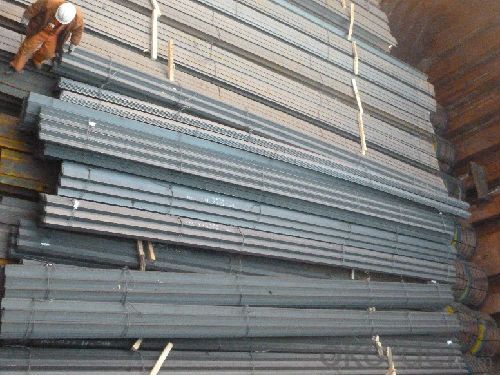
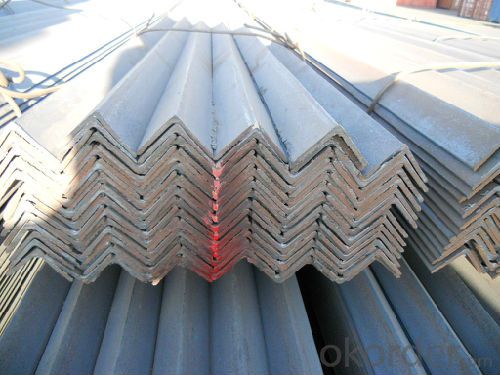
- Q: What are the typical lengths of steel angles?
- The typical lengths of steel angles vary depending on the specific application and industry standards. However, common lengths for steel angles range from 20 to 40 feet.
- Q: What are the different dimensions used to specify steel angles?
- The different dimensions used to specify steel angles depend on the specific standards and systems followed by different countries or industries. However, there are some common dimensions that are generally used to specify steel angles. 1. Leg Length: The leg length of a steel angle refers to the length of each of the two equal legs that form the angle. This dimension is typically measured from the inside of the angle and is denoted in millimeters or inches. 2. Thickness: The thickness of a steel angle is the measurement of the material's thickness from one side to the other. It is usually expressed in millimeters or inches. 3. Weight per Meter or Foot: The weight per meter or foot is an important dimension used to specify steel angles. It represents the weight of the angle per unit length and is calculated by multiplying the cross-sectional area of the angle by the density of the steel. The weight is commonly given in kilograms per meter (kg/m) or pounds per foot (lb/ft). 4. Cross-Sectional Area: The cross-sectional area is the total area of the steel angle's cross-section. It is calculated by multiplying the leg length and the thickness of the angle. The cross-sectional area is typically expressed in square millimeters or square inches. 5. Moment of Inertia: The moment of inertia is a measure of the resistance of the steel angle to bending. It is calculated based on the shape and dimensions of the angle's cross-section. The moment of inertia is commonly denoted as Ixx or Iyy and is expressed in millimeters to the fourth power or inches to the fourth power. 6. Radius of Fillet: The radius of fillet refers to the rounded corner between the legs of the steel angle. It is measured from the inside of the angle and is typically expressed in millimeters or inches. These dimensions are crucial in specifying steel angles as they provide important information about the size, weight, strength, and structural properties of the angles. They help engineers, architects, and manufacturers choose the appropriate steel angles for various applications, such as construction, infrastructure, machinery, and fabrication.
- Q: What are the different surface treatments available for galvanized steel angles?
- To enhance the appearance, durability, and resistance to corrosion of galvanized steel angles, there are various surface treatments available. Some commonly used treatments include: 1. Powder coating: This method involves applying a dry powder onto the surface of the galvanized steel angle, followed by heating to create a long-lasting and visually appealing finish. Powder coating can be customized to achieve different colors and textures, resulting in a high-quality surface treatment. 2. Painting: Galvanized steel angles can also be painted with different coatings, such as epoxy, polyurethane, or enamel paint. Painting adds an extra layer of protection against corrosion and can be tailored to meet specific aesthetic requirements. 3. Hot-dip galvanizing: This treatment is the initial process for galvanized steel angles. It involves immersing the angles in a bath of molten zinc, which forms a protective layer on the surface. Hot-dip galvanizing offers excellent corrosion resistance and is particularly suitable for outdoor applications. 4. Zinc electroplating: Similar to hot-dip galvanizing, zinc electroplating applies a thin layer of zinc to the steel angle's surface through an electrochemical process. This treatment offers good corrosion protection and can be combined with other surface treatments to enhance durability. 5. Anodizing: Anodizing is commonly used for aluminum surfaces but can also be applied to galvanized steel angles. This process creates a controlled oxide layer on the surface, improving corrosion resistance and providing a decorative finish. 6. Passivation: Passivation is a chemical treatment that eliminates iron and other impurities from the surface of galvanized steel angles. It enhances the steel's corrosion resistance by creating a passive oxide layer. When selecting a surface treatment for galvanized steel angles, it is crucial to consider specific application requirements, budget constraints, and desired aesthetic appearance. Seeking advice from professionals or suppliers can help determine the most suitable treatment for your needs.
- Q: How are steel angles made?
- Steel angles are made through a process called hot rolling. It starts with heating a large steel billet in a furnace at very high temperatures until it becomes malleable. The heated billet is then passed through a series of rollers to shape it into the desired angle profile. These rollers have grooves that match the desired angle dimensions, which allow the steel to be gradually formed into the angle shape. As the steel billet is pushed through the rollers, it is compressed and elongated, resulting in a longer and thinner piece of steel with the desired angle shape. This process helps to improve the mechanical properties of the steel, making it stronger and more durable. Once the steel angle is formed, it goes through a cooling process to stabilize its shape and prevent any deformation. It is then cut to the required length and undergoes various finishing processes, including straightening, surface treatment, and inspection, to ensure its quality and dimensional accuracy. Overall, the production of steel angles involves heating, rolling, cooling, cutting, and finishing processes, all designed to create high-quality and precisely shaped steel angles that can be used in various construction and manufacturing applications.
- Q: What are the different welding methods used for steel angles?
- There are several different welding methods commonly used for steel angles, including Shielded Metal Arc Welding (SMAW), Gas Metal Arc Welding (GMAW), Flux-Cored Arc Welding (FCAW), and Gas Tungsten Arc Welding (GTAW). Each method has its own advantages and suitability for specific applications, but all are capable of effectively joining steel angles and providing strong, durable welds.
- Q: What are the different methods of connecting steel angles together?
- When connecting steel angles together, there are various methods available depending on the specific application and structural needs. Some commonly used techniques include: 1. Welding: Utilizing a welding electrode, welding is an effective and frequently employed method. It involves melting the edges of the angles and joining them together, creating a permanent and robust connection. 2. Bolting: Another popular approach is bolting, which involves using bolts, nuts, and washers to secure the angles in place. This method allows for a strong connection that can also be easily disassembled if necessary. 3. Riveting: Riveting entails the use of metal pins known as rivets to connect steel angles. It requires drilling holes in the angles and inserting the rivets, which are then hammered or pressed to create a permanent connection. 4. Adhesive bonding: Adhesive bonding involves the use of industrial adhesives to connect steel angles. The adhesive is applied to the surfaces of the angles, which are then pressed together. This method provides a durable and corrosion-resistant connection. 5. Mechanical connectors: Mechanical connectors, such as steel clips or brackets, are also suitable for connecting steel angles. These connectors are designed to securely clamp the angles together, providing a rigid connection. When selecting the appropriate method, it is crucial to consider factors such as load-bearing requirements, structural design, and environmental conditions. Consulting with a structural engineer or a professional in the field is recommended to ensure the appropriate method is chosen for the specific application.
- Q: How do you reinforce a steel angle for added strength?
- There are various ways to reinforce a steel angle for added strength. One effective technique involves welding additional steel plates or gussets to the flanges of the angle. These plates or gussets are typically placed perpendicular to the angle and welded along their edges to create a stronger connection. This helps distribute the load and improve the structural integrity of the angle. Another approach is to create a sandwich-like structure by bolting or riveting additional steel plates or angles to the existing one. These additional elements can be positioned on either side or even on top of the existing angle, depending on the specific requirements. Bolting or riveting them together ensures a secure connection and enhances the overall strength of the angle. Furthermore, bracing techniques can also be employed to reinforce a steel angle. This involves adding diagonal steel members, commonly known as braces, to the angle. The braces are typically attached to the angle at multiple points using welding or bolting methods. By doing so, these braces help redistribute the forces acting on the angle and prevent excessive deflection or bending, thereby increasing its strength. It's important to consider factors such as the load or force the angle will experience, the desired level of strength, and the available resources when choosing a specific reinforcement method. Seeking guidance from a structural engineer or a professional in the field is highly recommended to ensure the appropriate reinforcement technique is chosen and implemented correctly.
- Q: What are the different types of steel angles used in bridges?
- A variety of steel angles are commonly utilized in bridge construction for different purposes. These include: 1. Equal Leg Angles: These angles possess equal legs and are frequently employed to provide structural support in bridge construction. They contribute stability and strength to the bridge structure. 2. Unequal Leg Angles: These angles have uneven legs and are used when additional strength or specific load-bearing requirements are necessary. They are often combined with equal leg angles to evenly distribute weight and provide support. 3. L-Shaped Angles: L-shaped angles serve various purposes in bridge construction, such as connecting beams and columns or offering additional support at connection points. They are often used in conjunction with other angle types to create a robust and well-supported bridge structure. 4. Tapered Angles: Tapered angles find application in bridges where a change in width or height is required. They are frequently utilized in bridge piers or abutments to ensure a seamless transition between different sections of the bridge. 5. Bent Angles: Bent angles are used in bridges that require a specific angle to accommodate the design or alignment of the bridge. These angles are often custom-made to suit the specific needs of the bridge construction project. 6. Hollow Structural Section (HSS) Angles: HSS angles are hollow steel sections employed in bridge construction to enhance strength and reduce the overall weight of the structure. They are commonly utilized in situations where weight reduction is a priority, such as in long-span bridges or bridges with high load-bearing requirements. Each of these steel angles serves a distinct purpose in bridge construction, and their selection depends on factors such as design requirements, load-bearing capacity, and structural stability necessary for the bridge.
- Q: What are the different surface treatments for steel angles?
- Steel angles offer a variety of surface treatments to enhance their durability, appearance, and resistance to corrosion. Here are some common treatments: 1. Hot-dip galvanizing: Immersing steel angles in molten zinc forms a protective coating. This treatment is ideal for outdoor use, offering excellent corrosion resistance against moisture and harsh weather conditions. 2. Powder coating: A dry powder paint is applied to the steel angles and then heated to form a durable coating. Powder coating provides various color options and improves resistance to chipping, scratching, and fading. 3. Electroplating: Through an electrochemical process, a metal layer such as zinc, nickel, or chrome is deposited onto the steel angles. Electroplating enhances both aesthetic appeal and corrosion resistance. 4. Priming and painting: Applying primer followed by paint creates a smooth surface and improves adhesion. Painting not only enhances appearance but also provides some protection against corrosion. 5. Anodizing: Typically used for aluminum angles but can also be applied to steel, anodizing creates an oxide layer through an electrolytic process. This treatment improves corrosion resistance, hardness, and color stability. Choosing the appropriate surface treatment for steel angles depends on the specific application and environmental conditions. Each treatment offers unique benefits in terms of corrosion resistance, aesthetics, and durability. Considering these factors ensures the longevity and performance of the steel angles.
- Q: How do steel angles perform in saltwater environments?
- Steel angles perform well in saltwater environments if they are made from corrosion-resistant alloys or are properly coated to protect against corrosion.
Send your message to us
Hot Rolled Steel Equal Angle Unequal Angle
- Loading Port:
- Tianjin
- Payment Terms:
- TT or LC
- Min Order Qty:
- 50 m.t.
- Supply Capability:
- 30000 m.t./month
OKorder Service Pledge
OKorder Financial Service
Similar products
Hot products
Hot Searches
Related keywords
